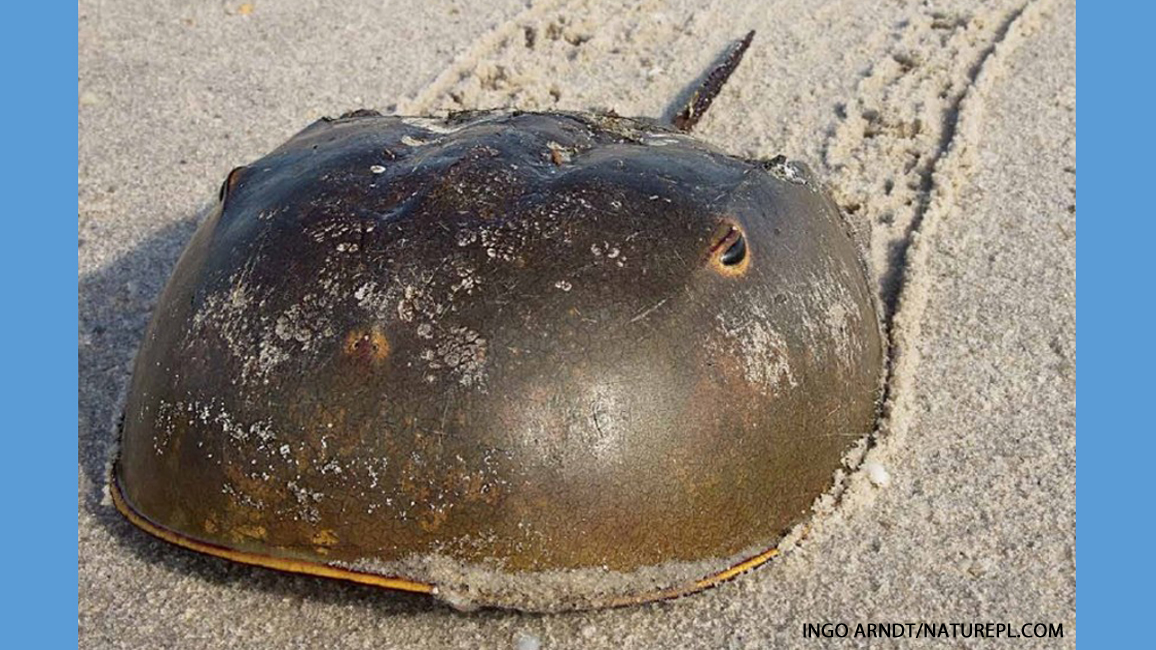
Horseshoe Crabs
By Kate HofmannFor millions of years, horseshoe crabs have come onto the beaches of Delaware Bay to mate and lay eggs. Stop by the beach after the sun comes up, and you just might meet one face to face!

Horseshoe crabs are sometimes called “living fossils.” That’s because they haven’t changed in millions of years. Modern horseshoes look just like their ancient ancestors.
These crabs get the first part of their name from the shape of their shells. But the “crab” part of the name doesn’t make quite as much sense. Horseshoes are closer cousins to ticks, spiders, and scorpions than they are to true crabs.
Hidden Legs
Under a horseshoe’s shell are its legs. As the crab walks along the ocean bottom, it digs up its favorite foods: worms and soft-shelled clams. But it doesn’t have any teeth to eat them with. So what does it do? It gets help from its spiny legs! As the legs move food toward the crab’s mouth, spines break it down into bite-sized bits.
Talented Tail
The horseshoe crab’s long, spiky tail may look as if it could sting or stab, but it’s really no threat. And it has some important jobs. In the water, it helps a swimming horseshoe steer. On shore, if a crab gets flipped over by the waves, the tail makes a good tool for turning right side up. Even so, sometimes flipping is a struggle. And an upsided-down crab can soon be in trouble. If its gills dry out in the sun, it will die. So if you see one that’s stranded bottom-side up, help it out: Just flip it!
All Eyes
A horseshoe crab has 10 eyes. Eight are simple ones that are scattered around its body. These sense just light and dark. The two large eyes on its shell see more, and they see nearly as well in the dark as in daylight. What might the crab want to spot with those eyes? A mate, of course!

Crab Tide
In Delaware Bay (see map above), horseshoes come out of the sea to mate on nights in May or June. The time is right when the tide is highest, during a full or new moon. Like armored tanks, the crabs advance onto the beach. The females dig nests and lay their eggs. Then the tag-along males fertilize the eggs with sperm. Over four or five nights, each female lays 80,000 eggs or more!
When their work is done, the crabs return to the sea. As they go, they leave looping trails like signatures in the sand.
Eggs Galore
More horseshoe crabs come ashore on the beaches of Delaware Bay than anywhere else in the world. As some crabs leave, more arrive. That means eggs in the earlier nests are often dug up as later crabs make their nests. Dug up eggs won’t hatch and eventually they dry out.
Those eggs don’t go to waste, though—not at all! They become part of an enormous egg feast. You see, horseshoe crabs aren’t the only ones traveling to these beaches. At the same time, huge flocks of hungry birds are making a great journey of their own. Keep reading to see what happens when they arrive.

An Eggs-cellent Feast
Red knots are robin-sized shorebirds on a mission. Every year, they migrate from the tip of South America to the Arctic—an amazing journey of more than 9,000 miles! The birds land only a few times to rest and refuel. Delaware Bay is their most important stop.
The knots (and many other shorebirds) arrive just as the horseshoe crabs lay their eggs. Huge flocks get busy feasting. Red knots need to double their weight in just two weeks, and that means every bird must eat thousands of eggs each day! (That sounds like bad news for the crabs, but don’t worry. The birds mostly eat the dug-up eggs that wouldn’t hatch anyway.)
Birds in Trouble
There is bad news, though. Beginning about 20 years ago, fewer and fewer crabs were coming ashore. There are many reasons for this. People were catching too many crabs, so there are fewer crabs to lay eggs. People built seawalls that blocked the beaches where crabs nest. And hurricanes and storms cause damage to beaches, as well.
All this means there aren’t as many extra eggs for the hungry birds. And that’s a big problem for the red knots. Without an egg feast, knots don’t have enough energy to get to the Arctic and lay their own eggs. The number of knots has been dropping steadily. And scientists say they could become extinct unless something is done.
But many people are trying to help. Several states have passed laws to ban or limit catching horseshoes. Because of these laws, the numbers of crabs have increased again in some places. But there are still challenges facing the crabs and the knots. Scientists are busy trying to learn more about these animals and their problems to try to help them.
Meanwhile, people hope that horseshoe crabs—and the birds that depend on them—will be around for millions more years to come!
















